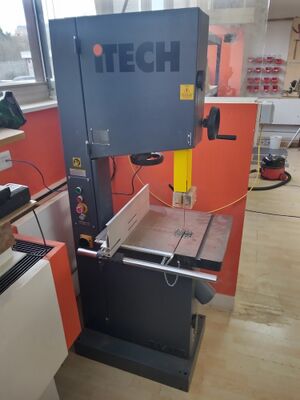Bandsaw (iTech)
| Bandsaw (iTech) | |
|---|---|
 | |
| Model | iTech BS400B |
| Sub-category | Woodworking |
| Status | Awaiting EX2 Setup |
| Last updated | 24 September 2024 07:27:59 |
| Training requirement | yes |
| Training link | lhs-induction-requests channel |
| ACnode | yes |
| Origin | Purchased for Space |
| Location | Wood shop |
| Maintainers | Wood shop team |
A large bandsaw for making straight or gently curved cuts in wood or plastic materials
This is a large machine superseding the old Startrite Bandsaw
Training is required and ACNode protected. To arrange training, post in the 'lhs-induction-requests' channel of our Discord Server
Machine Specs
- Wheel diameter 400 mm.
- Cutting width 390 mm.
- Cutting Depth 280 mm.
- Motor power 1.5kW 16a 1ph 230v.
- Blade length 3531 mm [139"]
- Max blade width 30 mm.
- Min blade width 6 mm.
- Dust connection 2 x 100 mm.
- Blade Speed 1500 m/min
- Nett weight 160 kg
- Dimensions 1680 x 770 x 650 mm
- Table height 860mm
- Table Size 578 x 420 mm
- C TYPE BREAKER REQUIRED
Maintenance and Cleaning Instruction
Ensure all the internal mechanics are cleaned once a month using the brush and the vacuum cleaner. If you are not sure how to do it ask the team.
Risk Assessment - Bandsaws
This risk assessment is intended to provide guidance on the risk associated with the above equipment and activities in normal use. Please also check general risk assessments for the space as a whole. Any discrepancies, errors or concerns should be raised with the document maintainers or trustees - do not edit this assessment directly. For responsible persons and last update, see 'version log' of the assessment page.
Activity
Cutting material with a bandsaw
Signage
Understanding Risk Rating
LOW - Ensure current control measures are in place and continue with activity
MED - Control measures may be adequate, co-supervision is recommended
HIGH - Do not undertake activity without further consultation with area specialists
Risk Assessment
| Identify Hazards | Who May be Harmed and How | Severity | Control Measures | Likelihood | Risk Rating |
|---|---|---|---|---|---|
| Incompetent user | User, Bystander | HIGH | Users must not use tools that they are not competent to use. Members must challenge use that they believe is dangerous. Users must read the user manual where applicable. Users must read the risk assessment before using a tool. Users will be advised during induction which tools they will need supervision or n induction to use. Only authorised members will complete maintenance and calibration tasks. | LOW | MED |
| Contact with blade | User | HIGH | Do not put hands into exclusion zone (within 10cm of blade). Use a push stick and the fence provided when making straight cuts. Do not move hands past the blade Saw should be turned off immediately after use Saw blade should stop within 10 seconds of being turned off. | LOW | MED |
| Drawing in (being pulled into the saw) | User | HIGH | User of the saw should not wear gloves, ties, scarves, or other long flowy clothing that could get pulled into the blade. Do not move hands past the blade | LOW | MED |
| Dust (inhalation, fire, explosion) | User, Bystander | MED | Stationary tools should be used with the workshop dust extractor. Maintenance must include the cleaning of dust from within the saw housing where accessible. A respirator or mask should be used whilst operating this tool for prolonged periods. | LOW | LOW |
| Blade snatching or jamming | User, Bystander | HIGH | Only cut wood and plastic on the band saw Do not attempt to make sharp angle cuts in one attempt Ensure a visual inspection of the band saw is undertaken before every use for physical obstructions | LOW | MED |
| Noise | User, Bystander | MED | Ear protection is advised. | LOW | LOW |
| Flying splinters | User, Bystander | HIGH | Eye protection must be worn In the workshop | LOW | MED |
Induction Script
The first stage of any induction is to read and familiarise with the Risk Assessment and PPE requirements
What is a BandSaw For
Cutting wood and plastic
- Straight cuts in thick material (within limits, generally 6"/150mm without checking)
- Stopped cuts eg tenons
- Small material you can't take near the mitre or table saws
- Gentle curves
- Generally, safer than circular blades (but not always 'safe')
Alternatives:
- Mitre saw better for straight cuts on strip
- Table saw better for straight rip cuts, where thickness allows
- Mini bandsaw and/ or scroll saw for tighter curves
Parts of the Saw
Point Out:
- The blade
- Inside the cabinet, the wheels
- The wheel tension adjustment
- The top and bottom guides
- The guide height adjuster
- The table
- The fence
- The fence rail adjustment
- The table bevel adjustment
- The on/off switch
How to Check the Blade Tension
How to Check the Guides
Straight Freehand Cutting
Straight Cutting with the Fence
Curve Cutting
After Use
- Always Sweep down the saw and the surrounding bench
- For now, always hoover inside the bottom box.
- Hoover inside the top box once a month or so. Once there is dust extraction the same will apply to the lower box.








